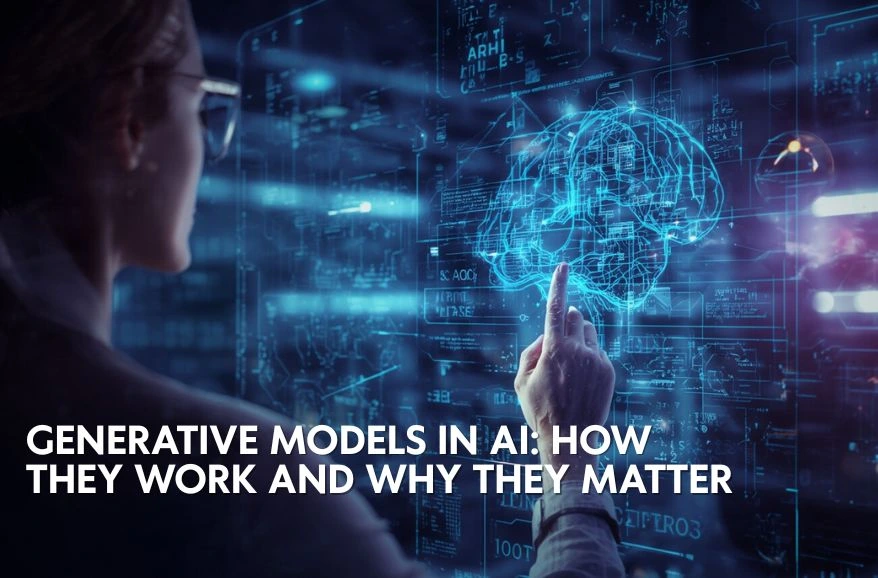
Generative models are changing the face of artificial intelligence, making machines generate content, draw data patterns, and solve complex problems in creative form. Generative models, unlike the traditional AI systems, which generate works based on data recognition and classification, generate novel, realistic works based on learnt trends. This blog will explain what generative models are, their operations, and why they are becoming a necessity in most industries. Learning these models can assist a business and a person to unlock the potential of AI-driven creativity and efficiency.
What Are Generative Models?
Generational AI is a type of AI that employs current data to learn trends and make new content, like text, images, music, or even code. When these models make original works, they often make them very hard to tell apart from works made by humans. These models apply generative deep learning and neural networks to produce output.
AI sorts information into categories, such as spam and not spam. On the contrary, generative AI generates new information that resembles, sounds like, or looks like a real-life example.
Main Goal of Generative AI
The main goal of generative AI is to create new original content that looks and acts similar to human creativity and to improve human skills. It makes the process faster and more effective. This process is facilitated by a generative AI learning path that analyzes large quantities of data to identify patterns and then uses this information to generate outputs, such as text, images, code, and music, in response to prompts. Ultimately, the main benefit of using generative AI in content creation is that it adds value to businesses and individuals by fostering innovation and streamlining tasks.
How Generative Models Work
Neural networks work like generative AI models as they use existing data to make new content based on how that data is trending. Using unsupervised or semi-supervised learning is a big step forward in this field because it lets businesses use a lot of unmarked data to build base models. Such models as GPT-3 and Stable Diffusion can be used as AI systems building blocks and do a variety of things. Examples are ChatGPT generative AI, a GPT-3-based application that generates short-question essays, and Stable Diffusion, which generates real-world photographs out of a text.
Types of Generative Models in AI
Generative Adversarial Networks (GANs)
- Generative Adversarial Networks (GANs) are made up of two neural networks: a generator and a discriminator.
- The generator produces random input in the form of new data (e.g., cat images) to generate more realistic data using training.
- The discriminator is used to distinguish between real and fake images and improves with time.
- Training entails an initiation, a cycle of data creation and classification, reverse flow, and sampling.
- It has been applied in image/video generation, style transfer, data augmentation, and in creative arts.
- CycleGAN is a noticeable image-to-image paired data non-translator.
Variational Autoencoders (VAEs)
- Generative AI can use training data to make new outputs, and Variational Autoencoders (VAEs) are effective at researching various data.
- VAEs are made up of an encoder (the data is compressed in latent space) and a decoder (it produces new images).
- They use probabilistic models to learn data variation in contrast to classical autoencoders.
- The activities in training are encoding, sampling a Gaussian distribution, decoding, loss calculation, and backprop.
- It can be applied to image generation, data compression, detection of anomalies, and natural language processing.
- The outputs of VAEs may exhibit blurriness, which motivates modifications such as adversarial training.
Diffusion Models
- Diffusion models are made by starting with random noise in data like pictures or sounds. Gradually making it easier to understand through a series of steps called denoising.
- Every step reverses a synthetic diffusion process that introduced noise to the real data as it was being trained.
- This is a highly precise and comprehensive approach to results, particularly when it comes to image generation, where models such as Stable Diffusion and DALL-E 3 have become a standard.
- Diffusion models can also be repurposed as an inpainting, style transfer model, or a text-based conditional generation model.
Other Models
- Autoregressive models: The autoregressive models produce data item by item, and each element is forecasted by past ones, and are typically used in NLP inference tasks such as text generation and translation.
- Large Language Models (LLMs): Large Language Models (encompassing both GPT and BERT) are autoregressive models, building on the concept of text generation, and are effective at a range of language tasks.
- Transformer models: It is a self-attention-based model with a focus on generative AI, especially within NLP, though it requires particular training to produce content.
- Flow-based models: Flow networks learn data structure and produce novel data points with high quality and faster syntax, but do not work as well with structured data.
Key Advantages of Generative AI
Generative AI offers several advantages:
- Accelerates research and Development: Generative AI reduces the amount of time required in research and development in different areas, such as science and technology. This increases new ideas faster and helps to solve hard problems in a faster manner.
- Gives further Personalization: Generative AI uses customizable content to create material unique to the user, depending on their preferences. This makes them more engaged and happy by providing customers with what they want or require. This also involves customized product designs and marketing.
- Encourages Non-Experts: Generative AI allows non-expert users to create quality content. This helps individuals to acquire new skills, become creative, and develop personally and professionally.
- Grows economies: Generative AI introduces new jobs and opportunities through the encouragement of new ideas, automation, and simplifying work. This results in the growth of the economy and the creation of new jobs in new locations.
Limitations of Generative AI Interfaces
Now, as we know the benefits, we will find out which are examples of a limitation of generative AI interfaces below:
- Dependability of Data: The outputs of the Generative AI can never be better than what it has been trained on. In case the training data is either biased, missing, or inaccurate, this information will be reflected in the created material.
- Absence of Control over the Outputs: It can produce outcomes that are not wanted or useful. Thus, it is difficult to control the contents and ensure that they satisfy the users.
- Lots of Data Processing Power: Generative AI models are physically hard to train and execute, possibly costing a lot of money and resources. This complicates the access of smaller groups or people.
- Ethical and legal issues: It is subject to abuse to create harmful information, such as deepfakes or fake news, that propagates fake information or invades the privacy of people. These moral and legal issues should be strictly controlled and observed to prevent abuse.
Applications of Generative Models Across Industries
AI in Creative Fields
Generative AI will increase the creativity through the assistance in the generation of new content with less difficulty. For example, AI can help fashion designers come up with new clothes or media companies come up with unique material for their subscribers. This will accelerate the processes of creativity and also render it more adaptable.
Generative AI in the Medical Industry.
Generative AI will assist doctors in assessing a patient to make certain treatment plans. It will also accelerate medical research, which shall aid the discovery of new medicines or the enhancement of treatments, which will result in improved patient care and patient outcomes.
Security and AI
On top of that, generative AI will play a big role in protecting cybersecurity by making it easier to find possible threats more quickly. AI will analyze and identify a huge amount of data constantly to prevent hacks and make online systems more secure.
Decentralized AI
More and more, blockchain technology in conjunction with AI will collaborate to create decentralized platforms. This will ensure that the information of users is not lost and their privacy is not violated. Individuals will be better in control of their personal information, and problems of trust will cease to exist with decentralized AI.
AI in video games and entertainment.
The world will be much more entertaining and individual to play games and watch films with generative AI. The creators will be in a position to provide individuals with individual narratives and worlds. Game worlds and characters can be created with more detail and speed with the aid of AI. This will thus enhance the gaming experience.
Future of Generative Models in AI
Smart Automation
With the help of data, generative AI will improve automation and help machines behave in smarter ways. Giving AI the ability to do things like keeping track of inventory or handling orders in some fields, like manufacturing, needs to be done quickly and correctly. This will facilitate the running of the business.
Hyper-personization
The AI based on the generative type will simplify the process of producing unique genai services and products for individual users. It will examine user data and behavior in order to develop special experiences, including individualized learning journeys in learning or tailored proposals in advertising. This will enhance interesting and pleasant conversations.
Conversational AI
Virtual assistants and customer support tools are going to be enhanced with generative AI. Plus, these tools will help them communicate better by decoding spoken instructions and answering more difficult questions and tasks. This will result in increased customer service and more delightful experiences for users.
Multi-Modal AI
Multi-modal AI is capable of dealing with and processing various types of data simultaneously, such as text, images, and videos. This will lead to more interactive experiences, such as letting speech and face recognition be used for safe log-ins or combining voice and image data to make shopping more personalized.
The Ethics and Rules of AI
As the growth of generative AI increases, there will be more focus on responsible use. Nations will develop standards to maintain balance in the use of AI, which is transparent and does not interfere with people. This will assist in making people trust AI systems and avoiding their misuse.
Actionable Steps for Businesses Exploring Generative AI
- Familiarize yourself with the basics of generative AI.
- Improve sales and marketing using custom campaign content.
- Auto-generate content with relation to the best generative AI tools, such as OwlyWriter, which saves time.
- Enhance customer experience using exact response templates.
- Maximize product description in order to increase conversions.
- Automate the process of data analysis.
- Combine AI with the systems available.
- Keep an eye on and refine AI-generated content regularly.
- Retain brand voice with AI education.
- Invest in the constant development of AI.
Conclusion
Generative models are one of the foundations of AI in the present day and the area of innovation, producing new and useful information. Their ability to enhance creativity, efficiency and problem solving have potentials in industries. Having knowledge and using generative models is one of the main keys to surviving the AI era, regardless of any difficulties that may come. When Gen AI solutions are deployed strategically, they have the potential to change businesses and society forever.



Leave a Reply